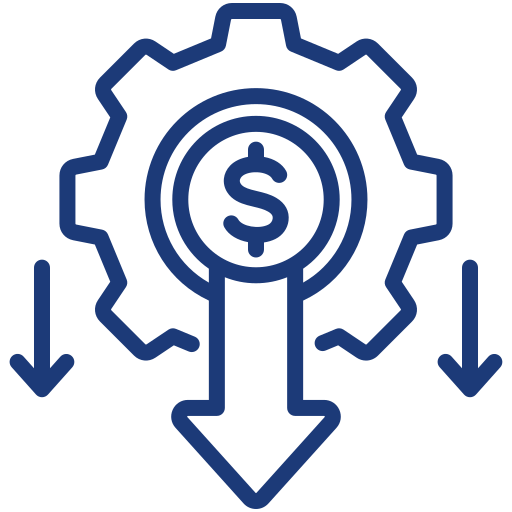RPA for Retail: Make back-office operations 10 times more efficiently
Transform Operations, Boost Efficiency & Compliance
Robotic Process Automation (RPA) is revolutionizing the retail industry by streamlining back-office operations and reducing costs. As retailers face increasing pressure to optimize efficiency while meeting evolving consumer demands, RPA provides powerful solutions for automating repetitive, rule-based tasks across the entire back-office operations. This comprehensive guide explores how RPA is transforming various aspects of retail operations

Enhanced Operational Efficienc
RPA automates a wide range of insurance processes, from claims processing to policy issuance. By automating routine tasks, insurance companies can reduce delays, minimize human error, and significantly speed up processing times. These all lead to improved service delivery and higher customer satisfaction.

Cost Savings
With RPA, insurance companies can automate labor-intensive tasks such as data entry, claims adjudication, and customer data management. This reduces the need for manual labor and eliminates costly errors, translating to considerable savings in operational costs. RPA enables insurers to operate more cost-effectively without compromising service quality.

Improved Accuracy and Compliance
In an industry driven by strict regulations, RPA ensures that processes such as claims handling, regulatory reporting, and underwriting adhere to compliance requirements. It minimizes the risk of human error and ensures that each task is completed in line with industry standards and regulations like Solvency II and GDPR.

Scalability and Flexibility
The insurance industry faces increasing competition and a growing customer base. RPA and AI algorithms allow companies to scale operations without needing to add significant resources. Whether handling seasonal peaks in claims processing or accommodating a growing volume of customer requests, RPA offers the flexibility to meet changing demands efficiently.
RPA Use Cases in Retail
Maintaining accurate and up-to-date product information across multiple sales channels is a complex task. RPA bots can automatically update product descriptions, pricing, images, and availability status across websites, marketplaces, and third-party platforms. They can also monitor competitor pricing and adjust prices according to predefined strategies.
RPA bots automate supplier background checks. The procurement or security department checks supplier background information by parsing data from different sources such as public register of legal entities or third-party web services such as Business Credibility Check Platforms. RPA bots execute the task 3 times faster on average and make sure that no human factor is involved.
RPA and OCR streamlines financial operations by automating invoice processing. Bots can match purchase orders to invoices, verify approvals, and process payments according to established business rules. For document understanding a combination of RPA and OCR is being used. OCR retrieves information from the invoice, then RPA enters extracted data such as invoice number, date, supplier details, reconciles it with purchase order and processes the order.
RPA bots are used to extract payment data from bank’s portals or payment data received via email and post them to ERP in accordance with accounting policy. RPA bots and ML analyse payment description and then assign it to the right business unit, general ledger account. ML might be used to make payment categorization correctly. For instance, ML analyzes the contract number in payment description and finds out that it was filled in incorrectly, the algorithm then can compare it with existing contracts and with 98%+ similarity assign it to the most likely contract.
RPA bots automatically gather the marketing campaign metrics from multiple online ads platforms such as Google Ads, Facebook Ads and save them in a file format for visualization and analytics in the dashboard. Files could be saved in the file storage and then uploaded to the Business Intelligence System.
RPA Implementation in Insurance
01
Process Assessment
Begin by analyzing your existing processes to identify automation opportunities and understand business metrics to be improved.
02
Custom Automation Design
A custom RPA solution that fits your unique needs is then being designed by the service provider or internal RPA team. Whether it’s for automating claims processing, underwriting, or customer service, RPA solutions are built to integrate seamlessly with existing systems.
03
Deployment and Integration
Once the RPA solution is developed, proceed with deployment and integration into your IT infrastructure. Ensure that the automation tools work seamlessly with your core systems and aim to minimize disruption and maximize productivity from day one.
04
Continuous Monitoring and Optimization
After deployment, a service provider or internal RPA team provides ongoing monitoring and optimization. Ensure that the RPA system continues to perform at its best.
Get Started with RPA for Retail Today
Discover how RPA can streamline your insurance processes, reduce costs, and improve customer satisfaction. Contact us today to learn how we can help automate your operations. Take your insurance business to the next level.
Our selected projects
We empower leading international companies to operate with x10 efficiency
FAQs
RPA can significantly add efficiency in the back-office operations such as accounting and finance as well as automate product portfolio management and marketing campaigns performance management. Moreover, retailers implement RPA to automate daily routine HR operations such as employee onboarding, IT processes such as user account management and others.
RPA can automate invoice processing and purchase order reconciliations which are routine and time-consuming tasks in most of retail business due to high volume of transactions. RPA and ML are used for bank payment posting to ERP, reconciliation of bank statements with trial balance and more. RPA enables retailers to save thousands of manhours spent on routine.
Key challenges include integration with legacy systems, which may require additional customization. There’s also employee resistance to automation due to concerns about job displacement. Also, data security needs to be ensured, especially when handling sensitive financial data. Additionally, maintaining RPA systems and scaling them across multiple processes can require continuous monitoring and updates.
RPA is suitable for retail companies of all sizes. Small retail can automate specific tasks like customer onboarding and claims verification. RPA helps them reduce operational costs and improve efficiency.
What our customers say
It was a great decision to get PythonRPA as a partner in our first ever RPA implementation within the organization. Apart from all the available features of their platform, I greatly appreciate the flexibility of the PythonRPA team to accommodate complex internal requirements from our information security and IT architects. Having all these pieces in place, we were able to successfully kick off RPA technology and create grounds for further scaling its benefits across multiple departments.

Sr. Transformation Lead, Home Credit Philippines.

“Immediately after the first bots appeared, department employees began to wonder why they had been doing this routine work for so long and not developing a business.”

Otbasy Bank

“I have worked with Python RPA for many years and have achieved outstanding results. We have automated business tasks across nearly all departments of our large company and are extremely satisfied with the speed and quality of automation it provides.”

RPA Business Analyst

“Advantages of the Python RPA platform helped speed up robot development by four times. It’s a pleasure to work with a high-quality domestic product. “

Head of IT department BI Innovations

“Python RPA enables us to automate our processes swiftly and efficiently, ensuring top-quality service for our customers”

Head of Department Metha & BPM & RPA

“I have worked with the Python RPA platform for many years. It’s robust functionality, responsive vendor team, and competitive license pricing make it an ideal solution for Aiyl Bank, the largest bank in Kyrgyzstan.”

Head of the Methodology Department, Business Process Automation and Modeling at Aiyl Bank



